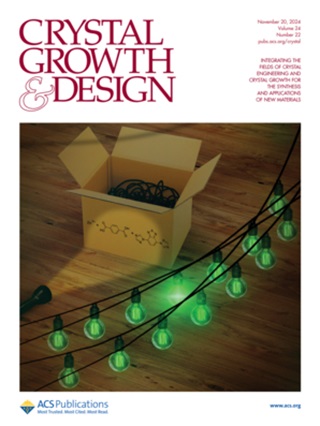可调谐发光的磺酰基钙[4]炔支撑 Ln8(Ln = Tb 和 Eu)配位轮中的离子位点置换
IF 3.2
2区 化学
Q2 CHEMISTRY, MULTIDISCIPLINARY
引用次数: 0
摘要
镧系元素配位团(LCC),即[Ln8(TC4A-SO2)4(TA)2(DMF)4(H2O)10](溶剂)(Ln8 = Tb8, Eu8, Tb4Eu4; H4TC4A-SO2 = p-ter-butylsulfonylcalix[4]arene;H4TA = dl-酒石酸),并通过单晶 X 射线衍射进行了表征。Ln8 是由四个锥形单核单元(LnIII-TC4A-SO2)和四个桥接的 LnIII 离子构成的轮状框架,中间的两个酒石酸盐充当 "辐条"。在 370 纳米的激发下,Tb8 在固态下显示出 53.3% 的非凡发光量子产率(QYs),而 Eu8 在类似条件下无法发光。此外,Tb8 在甲醇溶液中显示出浓度依赖性发射,最佳发光量子产率为 61.8%,是最佳发光铽基配位团簇之一。Eu离子可以按化学计量比合理地掺杂在Tb环(TbxEu8-x,4 ≤ x <8)的特定位点上,以调节发射色输出,这揭示了从TbIII的5D4-7F5和5D4-7F6电平到EuIII的5D0电平的高效能量转移。这项研究提出了一种独特的方法来控制 LCC 的制造和可调发光。本文章由计算机程序翻译,如有差异,请以英文原文为准。
![Ion Site Substitution in a Sulfonylcalix[4]arene-Supported Ln8 (Ln = Tb and Eu) Coordination Wheel with Tunable Luminescence](https://img.booksci.cn/booksciimg/2024-9/2024092110269365030620.png)
Ion Site Substitution in a Sulfonylcalix[4]arene-Supported Ln8 (Ln = Tb and Eu) Coordination Wheel with Tunable Luminescence
Lanthanide coordination clusters (LCCs), namely, [Ln8(TC4A-SO2)4(TA)2(DMF)4(H2O)10] (solvents) (Ln8 = Tb8, Eu8, Tb4Eu4; H4TC4A-SO2 = p-tert-butylsulfonylcalix[4]arene; H4TA = dl-tartaric acid), were synthesized via the solvothermal method and were characterized by single-crystal X-ray diffraction. Ln8 is a wheel-shaped framework built from four cone-shaped mononuclear units (LnIII-TC4A-SO2) and four bridging-LnIII ions with two tartrates located in the center serving as “spokes”. Tb8 exhibits an extraordinary luminescence quantum yield (QYs) of 53.3% in the solid state under the excitation of 370 nm, while Eu8 cannot emit under similar conditions. Furthermore, Tb8 shows concentration-dependent emission in a methanol solution with the best luminescence QYl of 61.8%, representing one of the best luminescent Tb-based coordination clusters. The Eu ions can be rationally doped in the Tb ring (TbxEu8–x, 4 ≤ x < 8) by a stoichiometric ratio on specific sites to tune the emission color output, which reveals the efficient energy transfer from 5D4-7F5 and 5D4-7F6 levels of TbIII to the 5D0 level of EuIII. This work presents a unique method of controlling the fabrication and tunable luminescence of LCCs.
求助全文
通过发布文献求助,成功后即可免费获取论文全文。
去求助
来源期刊

Crystal Growth & Design
化学-材料科学:综合
CiteScore
6.30
自引率
10.50%
发文量
650
审稿时长
1.9 months
期刊介绍:
The aim of Crystal Growth & Design is to stimulate crossfertilization of knowledge among scientists and engineers working in the fields of crystal growth, crystal engineering, and the industrial application of crystalline materials.
Crystal Growth & Design publishes theoretical and experimental studies of the physical, chemical, and biological phenomena and processes related to the design, growth, and application of crystalline materials. Synergistic approaches originating from different disciplines and technologies and integrating the fields of crystal growth, crystal engineering, intermolecular interactions, and industrial application are encouraged.
 求助内容:
求助内容: 应助结果提醒方式:
应助结果提醒方式:


